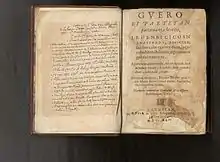Gero (book)
Gero (meaning 'later', Guero in contemporary spelling) is a 17th-century ascetic book in Basque composed by Pedro Agerre (also spelled Pedro D'Aguerre), better known as Axular. It is considered one of the masterpieces of classic Basque prose and literature altogether.

It was published at Bordeaux in 1643 under the patronage of Bertrand D'Etchauz, Basque archbishop of Tours (1617-1641). The book was written after the period of the harrowing "witch" persecution (Pierre de Lancre's intervention in Labourd). The book, written in an instructive tone, dwells on the idea of the harm and misfortunes issued from putting off one's religious duties, on the grounds that men need to turn to Christ with no delay.
While the title's tagline reads «divided into two parts», only the existence of one book has been attested. Basque scholar Pierre Lafitte claimed that both parts had been merged into one. By contrast, former president of the Basque Language Academy Luis Villasante held that the second part had been actually lost for ever. Gero shows no mysticism, but the book intends to explain and prove an ascetic idea, arranged as if it was to be addressed from the pulpit to the parishioners.
Its accomplished, elaborate language in classic Lapurdian dialect turned it into a writing model for later writers from Labourd.